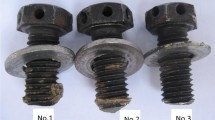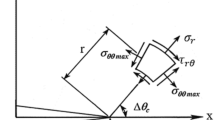Abstract
Engines cylinder head bolts failure from the thread location in cylinder block causes the problems during repairing time. Exact prediction of fatigue crack growth in bolts by experimental analysis and finite element method modeling can affect the Maintenance Planning and Scheduling Implementation. In this study, the fatigue analysis of cylinder head bolts of a four-cylinder gasoline engine imposed by premature failure is investigated. The bolts suffer a mechanical seizure on the threads about 2 × 108 cycles in service. For such aim, standard specimens are cut off from the bolts and examined to evaluate the mechanical properties and material chemical composition. Optical microscopes and scanning electron microscopy are employed to consider the microstructures, defects, fracture surface and failure cause. The morphology of the fracture surface shows the fatigue crack growth marks, including the beachmarks, the ratchet marks and the river cracks. The finite element analysis model is presented applying the elastic–plastic finite element analysis for the bolts under variable combustion pressure. The stress history is then used to calculate stress intensity factors and fatigue life of bolts. Numerical results show that crack existence to depth of 0.35 mm is the source of failure of premature fracture.















Similar content being viewed by others
Abbreviations
- \( {\text{HV}} \) :
-
Vickers hardness (HV)
- \( F_{G} \) :
-
Maximum gas force (N)
- \( F_{\text{PT}} \) :
-
Pre-tightening force (N)
- \( F_{T} \) :
-
Force generated by the engine heat (N)
- \( A_{\text{Cyl}} \) :
-
Cylinder area (m2)
- \( K_{I} \) :
-
Stress intensity factor (MPa.m0.5)
- \( F_{I} \) :
-
Boundary correction factor (−)
- \( B_{S} \) :
-
Applied tensile stress (MPa)
- \( K_{ \rm{max} } \) :
-
Maximum mode I stress intensity factor (MPa.m0.5)
- \( K_{\text{op}} \) :
-
Crack first opens (MPa.m0.5)
- \( \Delta K_{\text{eff}} \) :
-
Effective stress intensity factor (MPa.m0.5)
- \( C \) :
-
Material constant (m/cycle)
- \( n \) :
-
Material constant (−)
- \( k \) :
-
Nut factor
- \( i \) :
-
Number of cylinder head bolts per any cylinder
- \( N \) :
-
Fatigue life (cycle)
- \( a_{0} \) :
-
Crack initial length (m)
- \( a_{f} \) :
-
Crack final length (m)
- \( \alpha \) :
-
Correction coefficient
- \( \emptyset \) :
-
Parametric angle
- \( \sigma \) :
-
Stress (Pa)
- G :
-
Gas
- Cyl:
-
Cylinder
- f :
-
Final
- tot:
-
Total
- max:
-
Maximum
- eff:
-
Effective
- p :
-
Proposed
References
Nami A, Aliakbari K, Ahmadipoor M, Mahdiloo AR (2019) Failure analysis of gasoline engine cylinder head bolts. In: 4th national conference in materials engineering. chemical engineering and industrial safety
Gong Y, Ding Q, Yang ZG (2019) Failure analysis on premature fracture of anchor bolts in seawater booster pump of nuclear power plant. Eng Fail Anal 97:10–19
Fonte M, Reis L, Infante V, Freitas M (2019) Failure analysis of cylinder head studs of a four stroke marine diesel engine. Eng Fail Anal 101:298–308
Yu Z, Xu X (2006) Failure analysis of diesel engine cylinder head bolts. Eng Fail Anal 13:826–834
Aliakbari K (2019) Failure analysis of base plate bolts of radial forging machine. J Stress Anal 4(1):89–98
Casanova F, Mantilla C (2018) Fatigue failure of the bolts connecting a Francis turbine with the shaft. Eng Fail Anal 90:1–13
Zhu X, Xu J, Liu Y, Cen B, Lu X, Zeng Z (2017) Failure analysis of a failed connecting rod cap and connecting bolts of a reciprocating compressor. Eng Fail Anal 74:218–227
Molaei SH, Alizadeh R, Attarian M, Jaferian Y (2015) A failure analysis study on the fractured connecting bolts of a filter press. Case Stud Eng Fail Anal 4:26–38
Kong H, Liu D, Jiang T (2015) U-shaped bolts fracture failure analysis. Procedia Eng 99:1476–1481
Qiu M, Yan J, Zhao B, Chen L, Bai Y (2012) A finite-element analysis of the connecting bolts of slewing bearings based on the orthogonal method. J Mech Sci Technol 26(3):883–887
Jeong JH, Lee HK, Park K, Kim JB (2015) An investigation into the anti-releasing performance of a serrated bolt. J Mech Sci Technol 29(12):5127–5132
Pilone D, Brotzu AA, Felli F (2015) Failure analysis of connecting bolts used for anchoring streetlights of a mountain highway. Eng Fail Anal 48:137–143
ASTM E415–14 (2014) Standard test method for analysis of carbon and low-alloy steel by spark atomic emission spectrometry. ASTM International, Philadelphia
ASTM E1086–14 (2014) Standard test method for analysis of austenitic stainless steel by spark atomic emission spectrometry. ASTM International, Philadelphia
ASTM E384–11e1 (2011) Standard test method for knoop and vickers hardness of materials. ASTM International, Philadelphia
ASTM A370–97a (2001) Standard test methods, and definitions for mechanical testing of steel products. ASTM International, Philadelphia
Aliakbari K, Farhangdoost KH (2014) Plastic deformation influence on material properties of autofrettaged tubes used in diesel engines injection system. J Press Vessel Technol 136:041402-1–041402-6
Aliakbari K, Farhangdoost KH (2014) The investigation of modelling material behavior in autofrettaged tubes made from aluminium alloys. Int J Eng 27:803–810
Zhang Q, Zuo Z, Liu J (2013) Failure analysis of a diesel engine cylinder head based on finite element method. Eng Fail Anal 34:51–58
Kılıçaslan C, İnce U (2016) Failure analysis of cold forged 37Cr4 alloy M10x28 bolts. Eng Fail Anal 70:177–187
ASTM E647-11 (2011) Standard Test Method for Measurement of Fatigue Crack Growth Rates. ASTM Int 3:1–46
DIN EN 10083-3:2007-01 (2007) Steels for quenching and tempering-Part 3: technical delivery conditions for alloy steels
Park JH, Kim DS (2005) Effect of CaO–Al2O3–MgO slags on the formation of MgO–Al2O3 inclusions in ferritic stainless steel. Metall Mater Trans B 36:495–502
Lyu S, Ma X, Chen M, Huang Z, Yao Z, Wang G, Zhao B (2020) Application of phase equilibrium studies of CaO–SiO2– Al2O3–MgO system for oxide inclusions in Si-deoxidized steels. Calphad 68(101721):1–8
Yuan H, Liu H, Ren X, Zhang X, Ai D, Luo Y (2019) The bearing performance of the bolt-sphere joints with stochastic pitting corrosion damage. J Constr Steel Res 160:359–373
Craig P, Serkan S, Hagan P, Hebblewhite B, Van-dermaat D, Crosky A, Elias E (2016) Investigations into the corrosive environments contributing to premature failure of Australian coal mine rock bolts. Int J Min Sci Technol 26:59–64
Wu S, Chen H, Lamei H, Hagan PC, Hebblewhite B, Crosky A, Saydam S (2018) Investigation of cable bolts for stress corrosion cracking failure. Constr Build Mater 187:1224–1231
Wu S, Chenb H, Craiga P, Ramandia HL, Timmsa W, Hagana PC, Crosky A, Hebblewhitea B, Saydama S (2018) An experimental framework for simulating stress corrosion cracking in cable bolts. Tunn Undergr Space Technol 76:121–132
ISO 898-1:2013 (en) (2013) Mechanical properties of fasteners made of carbon steel and alloy steel- Part 1: bolts, screws and studs with specified property classes—coarse thread and fine pitch thread
Grimsmo EL, Aalberg A, Langseth M, Clausen AH (2016) Failure modes of bolt and nut assemblies under tensile loading. J Constr Steel Res 126:15–25
Aliakbari K (2019) Failure analysis of four-cylinder diesel engine crankshaft. J Braz Soc Mech Sci Eng 41(1):30–41
American Society for Metals, and ASM International (1987) ASM Handbook. Vol. 12. https://doi.org/10.31399/asm.hb.v12.9781627081818
Aliakbari K, Safarzadeh N, Mortazavi SS (2018) Analysis of the crankshaft failure of wheel loader diesel engine. Int J Eng 31:473–479
Shigley’s JE (2012) Mechanical Engineering Design, 9th edn. Mc-Graw-Hill, Chapter, p 8
Bowman Distribution-Barnes Group (1985) Fastener facts. Cleveland, Ohio
Infante V, Silva JM, Silvestre M, Baptista R (2013) Failure of a crankshafts of an aeroengine: a contribution for an accident investigation. Eng Fail Anal 35:286–293
Freitas MD, François D (1995) Analysis of fatigue crack growth in rotary bend specimens and railway axles, Fatigue Fract. Eng Mater Struct 18:171–178
Fonte M, Freitas M (1997) Semi-elliptical crack growth under rotating or reversed bending combined with steady torsion, Fatigue Fract. Eng Mater Struct 20:895–906
Fonte M, Freitas M (1999) Stress intensity factors for semi-elliptical surface cracks in round bars under bending and torsion. Int J Fatigue 21:457–463
Shiratori M, Miyoshi T, Sakay Y, Zhang GR (1987) Factors analysis and application of influence coefficients for round bar with a semi-elliptical surface crack. In: Murakami Y (ed) Handbook of Stress Intensity Factors, vol 2. Pergamon Press, Oxford
Hellen TK (1975) On the method of virtual crack extension. Int J Numer Meth Eng 9:187–207
Parks DM (1974) A stiffness derivative finite element technique for determination of elastic crack tip stress intensity factor. Int J Fract 10:487–502
Forman RG, Kearney VE, Engel RM (1976) Numerical analysis of crack propagation in cyclic-loaded structures. J Basic Eng 89:459–463
Elber W (1971) The significance of fatigue crack closure, in damage tolerance in aircraft structures. ASTM STP 486:230–242
NASA (2000) Fatigue Crack Growth Computer Program NASGRO Version 3.0, Reference Manual. JSC-22267B, NASA, Lyndon B. Johnson Space Center, Texas
Anderson TL (1994) Fracture Mechanics, fundamentals and applications, 2nd edn. CRC Press, Boca Raton
Newman JJ (1984) A crack opening stress equation for fatigue crack growth. Int J Fract 24(4):131–135
Murakami Y (1987) Stress intensity factors handbook, vol 1. Pergamon Press, Oxford
Mehrzadi M, Taheri F (2012) The influence of negative and positive stress ratios on crack growth rate in AM60B magnesium alloy. Mater Sci Eng, A 545:68–77
Fukumura N, Suzuki T, Hamada S, Tsuzaki K, Noguchi H (2015) Mechanical examination of crack length dependency and material dependency on threshold stress intensity factor range with Dugdale model. Eng Fract Mech 135:168–186
Masoudi Nejad R, Farhangdoost KH, Shariati M (2015) Numerical study on fatigue crack growth in railway wheels under the influence of residual stresses. Eng Fail Anal 52:75–89
Aliakbari K, Imanparast M, Masoudi Nejad R (2019) Micro-structure and fatigue fracture mechanism for a heavy-duty truck diesel engine crankshaft. Sci Iranica B 26(6):3313–3324
Acknowledgments
The authors would like to appreciate sincere cooperation of Mr. M. Esfidani (Materials Mechanical Properties Laboratory, Ferdowsi University of Mashhad) and Mr. D. Khademi (Electron Microscopy Research Core, FUM Central Laboratory).
Author information
Authors and Affiliations
Corresponding author
Additional information
Technical Editor: João Marciano Laredo dos Reis.
Publisher's Note
Springer Nature remains neutral with regard to jurisdictional claims in published maps and institutional affiliations.
Rights and permissions
About this article
Cite this article
Aliakbari, K., Akbarpour Mamaghani, T. Analysis of fatigue crack growth in cylinder head bolts of gasoline engine based on experimental data. J Braz. Soc. Mech. Sci. Eng. 42, 244 (2020). https://doi.org/10.1007/s40430-020-02326-1
Received:
Accepted:
Published:
DOI: https://doi.org/10.1007/s40430-020-02326-1




